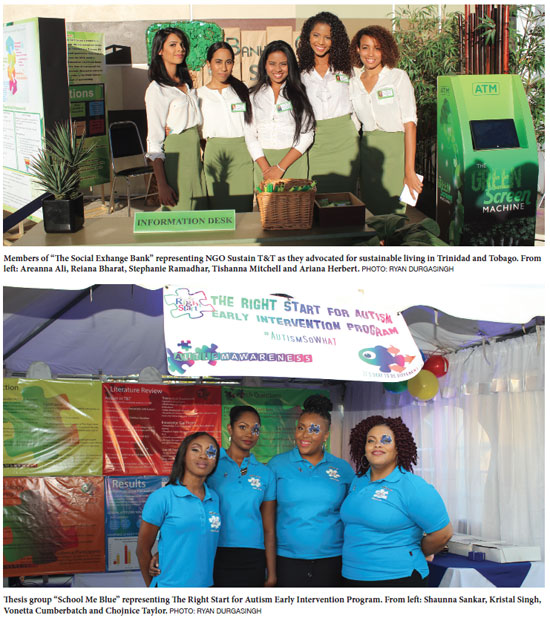
 The scene at the Daaga Auditorium on the evening of April 7 starkly resembled a teeming networking event. It was abuzz with eager exchange. Students commanded their spaces as they ushered lecturers, guests and students alike into their themed booths. The magnitude of their efforts was apparent as the Research Exposition marked the culmination of the Communication Studies Programme’s year-long thesis project. The scene at the Daaga Auditorium on the evening of April 7 starkly resembled a teeming networking event. It was abuzz with eager exchange. Students commanded their spaces as they ushered lecturers, guests and students alike into their themed booths. The magnitude of their efforts was apparent as the Research Exposition marked the culmination of the Communication Studies Programme’s year-long thesis project.
The third-year Communication Studies students at The UWI were charged with the task of identifying and proposing impactful solutions to various communication issues within ten local and international non-governmental organizations. The students were given carte blanche to investigate and solve these communicative puzzles by implementing critical thinking skills and the necessary theoretical frameworks – with their findings and progress showcased at the Research Exposition.
Heavily dependent on their command of communication theory and creative discernment, the practicum showed duality in its process. Once assigned to an organization, the students immediately became researchers but simultaneously served as branding consultants, working directly in the field.
The Exposition showcased students’ work in organizations such as the United Nations High Commission for Refugees, Habitat for Humanity, D Body Architect, Kids in Need of Direction (KIND) and The University of the West Indies Alumni Association. The breadth of the areas of interest was far-reaching but with a common denominator of social outreach. Undergraduate Communication Studies coordinator and lecturer, Dr. Keston Pierre, recounted the genesis of the Exposition from a centralized idea of social marketing. Wanting to foster positive behaviour change in local communities, he found that the best way to fulfill this purpose was through partnerships with non-governmental agencies and small businesses versus traditional media fora. He hoped too for increased media coverage of the event to build awareness and sustainability of the project.
This year marked the second instalment of this collaboration with non-profit organizations, and Dr. Pierre observed that students were keen and their investment in gaining real world experience was pronounced. This interest was remarkably evident in the booth that showcased their work with “The Right Start Early Intervention” programme for young children living with autism. Their booth set-up was a mock pre-school classroom, complete with sensory friendly activity sets, mats and a mini-golf station against the backdrop of branded banners detailing their research process. The group members gave impassioned accounts of their findings with child-friendly painted faces as though they were teachers and specialists working at the early intervention centre.
he students assisted in executing the organization’s annual “Light it Up Blue” campaign during the month of April, where various Prestige Holdings buildings across the country are illuminated blue, the colour of autism awareness. Natasha Scott, a resident speech therapist at the programme, lauded the students’ work as being intensely diagnostic of the levels of social awareness of the initiative. Scott added that through the use of popular culture and social media, the students were able penetrate new demographics beyond the remit of those directly affected by autism and effectively increase awareness, particularly among young people.
Humanities and Education Dean, Dr. Heather Cateau, said the Exposition is on a positive growth path. “It gets better every year and what is most striking this year is the theme of social consciousness – something that is needed in Trinidad and Tobago today.”
Building upon this motif of social consciousness was the work of the “Comm-sultants” with their work for the organization “Moms For Literacy.” They focused primarily on gaining media coverage for the organization and increasing the enrolment of the initiative’s reading programme. The team worked with cultural news network, Gayelle, to produce a television advertisement to be run for a six-month period and aired during prime time. The advertisement focuses on sensitizing the public about the importance of mothers reading with their children and highlights the importance of literacy as a viable tool against crime and poverty.
There was also significant emphasis on green development through works with non-profits like “Sustain T&T” where students drafted proposals for environmental NGOs to gain necessary funding from banks. Similarly, students developed a branding strategy for the green non-profit, “Grow-It” to connect with children in rural areas and develop their interests in agriculture via an “Agri-Kit” that contains soil and seeds for their own planting.
Undoubtedly, the Research Exposition showcased the ideal of students taking stock of their unique positions as communicators within salient arenas of our society. Their practical and creative skills were brought to the fore in a dynamic way, as they were able to effect sustainable changes within the partnered organizations and their beneficiaries. Overall, the event demonstrated the formidable potential of young persons as conduits of social change and awareness.
–Genève Hyndman is a Communication Studies Major student at The UWI St. Augustine Campus. |





